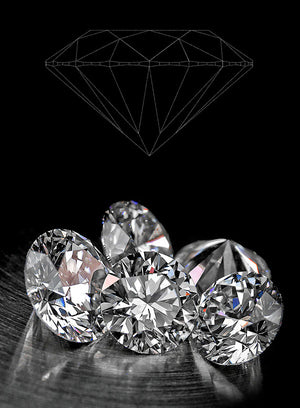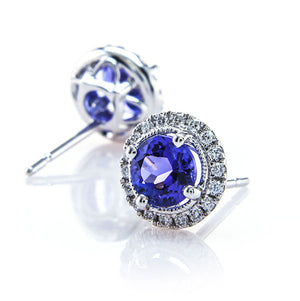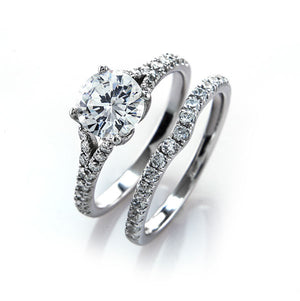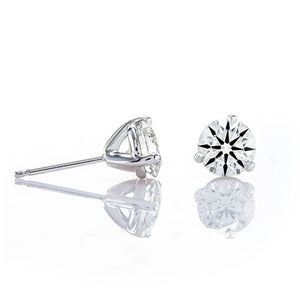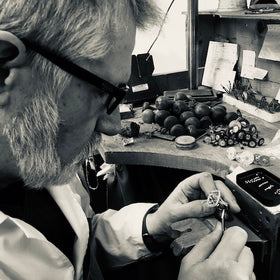Standard Ideal vs Super Ideal Cut Diamonds
"I am looking for a one carat round diamond that will be used for a four prong solitaire style engagement ring. I am only interested in GIA Excellent or AGS Ideal cut, and thought that limiting my search to diamonds of that overall cut quality would provide me with the best options. However I’ve recently run across the term “super ideal cut diamonds' which seem to be cut beyond the standards of the AGS Ideal and GIA Excellent cut grades.
Can you tell me more about super ideal cut vs excellent cut diamonds? Are they worth the premium? And what I should search for if I truly want a diamond that offers the best visual performance? I’m not so worried about the name per se, I simply want the very best, brightest, most sparkly diamond available.
With that in mind, I prefer VS-2+ clarity, and D-E color with fluorescence between none and medium blue. My preferred price range is $10-11k, but I can stretch to $12K, plus the setting.”
AGS Ideal-0 cut versus GIA Excellent cut diamonds:
I suppose that the best place to start is by addressing the difference between AGS Ideal-0 and GIA Excellent cut round brilliant cut diamonds. As a matter of fact, the grading standards of the two gemological laboratories are comparable for the following characteristics:
Be that as it may, the criteria for diamond cut quality is dramatically different. As a matter of fact, only the American Gem Society Laboratory (AGSL) grades diamonds for light performance. In fact, the
Angular Spectrum Evaluation Tool (ASET) is proprietary to the AGS Laboratory.
We will discuss the advantage of ASET in a moment. Before we do that, you should also know that the two laboratories measure diamond proportions in different manners.
Diamond Proportions Are a Matter of Perspective:
In the first place, this might seem confusing because both labs use Sarine technology to measure the diamonds. However, they use different proprietary packages in order to do so. In other words, the AGS and GIA use the same technology to measure diamonds differently.
Under those circumstances, your perception of diamond proportions may vary depending on the perspective of each laboratory. To begin with, both gemological laboratories use Sarine computerized proportions technology to measure diamonds and calculate the proportions.
In order to do this, the Sarine unit measures eight facets per section. Then, it adds those numbers together and divides the sum by eight to determine the average. As a matter of fact, that part of the process is straightforward and makes perfect sense.
A Proprietary Blend of Creative Calculations:
To begin with, the proprietary software that each lab uses takes the measurements from different perspectives. For example, one lab measures the girdle edge from the mid-point of the valley. While the other laboratory measures the peaks and the valleys. In similar fashion, they measure the lower girdle halves from different vantage points.
Be that as it may, those differences in technique are only the beginning of what sets these labs apart. Because the AGSL reports the average measurements that the machine provides in a straightforward manner. In other words, if the average pavilion depth is 43.1% then that is what is stated on the lab report.
However, the
Gemological Institute of American Gem Trade Laboratory (GIA-GTL) rounds off some measurements to the nearest half a percent, or half a degree in some cases. Of course, that depends on whether the measurement is being reported in percent or degrees. Under those circumstances, the system provides a lot of wiggle room for the cutters.
From our perspective, you can drive a truck through the proportions scale employed by the GIA Laboratory and still receive an excellent rating. In that case, the concept of trying to buy a diamond by the numbers seems like an exercise in futility. After all, you’re trying to make a precise assessment of light performance based on imprecise data. In addition, the proportions are only one piece of the puzzle because they merely set the stage for possibility.
The Key to Unlocking Maximum Light Performance:
As stated previously, the proportions of a diamond only set the stage for light performance. In other words, the proportions provide potential. However, the degree of optical precision will determine the degree of light leakage or return. As well as the volume and intensity of the sparkle factor.
The degree of optical precision is dependent on the consistency of facet shape, size, and the alignment of the facets from the perspective of 360-degrees. As such, any variance in the shape, size, or the alignment of the facets will have a direct impact on light performance. Under those circumstances, it seems obvious that you want a diamond that exhibits the highest degree of optical precision.
Unfortunately, the degree of optical precision is where the vast majority of standard ideal cut diamonds fall short. That’s because it can take up to 4X longer to polish an ideal cut diamond to exhibit a higher degree of optical precision.
In that case, it costs more to produce a super ideal cut diamond as opposed to their standard counterparts. And since the gemological laboratories don’t take optical precision into account as part of their grading standard, most diamond buyers aren’t even aware of the differences. At least as far as the paper grades go, because the difference in sparkle factor is clearly apparent.
AGS ASET, Angular Spectrum Evaluation Technology:

To begin with, the Light Performance grading platform of the AGS Laboratory does not account for optical precision. However, it does provide insight into how evenly a diamond may be reflecting light. Plus, it lets us know where in the hemisphere the light is gathering from.
As a matter of fact, the different colors of an ASET Scope image represent different intensities and contrast. In that case, Angular Spectrum Evaluation Tool (ASET) provides savvy diamond buyers with a clear advantage.
However, the ASET map on the diamond grading report is a compilation of data obtained at multiple stopping points during the scan process. As such, the map on the diamond quality document (DQD) does not provide insight into light leakage or return.
Although that may be true, a high-resolution photograph of the diamond as seen through an ASET Scope can be used to determine the degree of light return or leakage. That is one of the reasons why
Brian Gavin Diamonds provides an ASET Scope image independent of the one provided on the AGS Diamond Quality Document.
In addition, additional insight may be provided via Advanced ASET. Under those circumstances, the lab report will feature multiple ASET maps that show the results from the vantage point of 30 and 40-degrees.
As a matter of fact, this is the basis for the 33.5-degree ASET map that is standard on Platinum Light Performance reports.
Super Ideal Cut vs Excellent / Ideal cut diamonds:

In the first place, the term “
super ideal cut” is not an official designation of diamond cut quality. As a matter of fact, it is more of a general term that exists within the niche of hearts and arrows diamond enthusiasts. Obviously, it is a classification that is based on the differences that exist within the realm of ideal cut diamonds.
After all, the gemological labs don’t take optical precision into account as part of the grading process. However, there are clear differences in performance that exist within that classification of cut.
For example, it’s been estimated that fewer than 0.001% of round diamonds are cut to the higher degree of optical precision necessary to produce a crisp and complete pattern of hearts and arrows.
That makes puppies like this
1.003 carat, E-color, VS-2 clarity, Black by Brian Gavin round hearts and arrows cut diamond a rare find.
The Proof Is in the Performance:

Remember to look beyond the basic details provided on the diamond quality document. Because the only way to judge optical precision is to evaluate the precision of the hearts and arrows pattern using an H&A Scope.
In that case, you’ll be able to (1) determine whether the diamond exhibits a crisp and complete pattern of hearts and arrows. But also, (2) judge the consistency of that pattern, and (3) look for differences in the size and shape of the hearts; and (4) determine whether the tips of the hearts are twisting in one direction or the other; and (5) look at the spacing around the edge of the hearts; and (6) see how any differences may be affecting the pattern of light return in the face-up position.
Because if you spend enough time looking at the hearts and arrows images, you will begin to see the correlation between the degree of optical precision.
Remember, that is the consistency of facet shape, size, and alignment. And, how light reflects throughout the diamond in the face-up position. Of course, the more that you learn about diamond light performance, the more you will appreciate
Brian Gavin Diamonds.
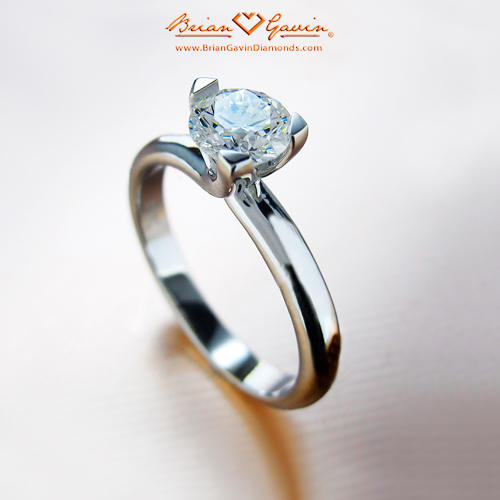
 To begin with, the Light Performance grading platform of the AGS Laboratory does not account for optical precision. However, it does provide insight into how evenly a diamond may be reflecting light. Plus, it lets us know where in the hemisphere the light is gathering from.
As a matter of fact, the different colors of an ASET Scope image represent different intensities and contrast. In that case, Angular Spectrum Evaluation Tool (ASET) provides savvy diamond buyers with a clear advantage.
However, the ASET map on the diamond grading report is a compilation of data obtained at multiple stopping points during the scan process. As such, the map on the diamond quality document (DQD) does not provide insight into light leakage or return.
Although that may be true, a high-resolution photograph of the diamond as seen through an ASET Scope can be used to determine the degree of light return or leakage. That is one of the reasons why Brian Gavin Diamonds provides an ASET Scope image independent of the one provided on the AGS Diamond Quality Document.
In addition, additional insight may be provided via Advanced ASET. Under those circumstances, the lab report will feature multiple ASET maps that show the results from the vantage point of 30 and 40-degrees.
As a matter of fact, this is the basis for the 33.5-degree ASET map that is standard on Platinum Light Performance reports.
To begin with, the Light Performance grading platform of the AGS Laboratory does not account for optical precision. However, it does provide insight into how evenly a diamond may be reflecting light. Plus, it lets us know where in the hemisphere the light is gathering from.
As a matter of fact, the different colors of an ASET Scope image represent different intensities and contrast. In that case, Angular Spectrum Evaluation Tool (ASET) provides savvy diamond buyers with a clear advantage.
However, the ASET map on the diamond grading report is a compilation of data obtained at multiple stopping points during the scan process. As such, the map on the diamond quality document (DQD) does not provide insight into light leakage or return.
Although that may be true, a high-resolution photograph of the diamond as seen through an ASET Scope can be used to determine the degree of light return or leakage. That is one of the reasons why Brian Gavin Diamonds provides an ASET Scope image independent of the one provided on the AGS Diamond Quality Document.
In addition, additional insight may be provided via Advanced ASET. Under those circumstances, the lab report will feature multiple ASET maps that show the results from the vantage point of 30 and 40-degrees.
As a matter of fact, this is the basis for the 33.5-degree ASET map that is standard on Platinum Light Performance reports.
 In the first place, the term “super ideal cut” is not an official designation of diamond cut quality. As a matter of fact, it is more of a general term that exists within the niche of hearts and arrows diamond enthusiasts. Obviously, it is a classification that is based on the differences that exist within the realm of ideal cut diamonds.
After all, the gemological labs don’t take optical precision into account as part of the grading process. However, there are clear differences in performance that exist within that classification of cut.
For example, it’s been estimated that fewer than 0.001% of round diamonds are cut to the higher degree of optical precision necessary to produce a crisp and complete pattern of hearts and arrows.
That makes puppies like this 1.003 carat, E-color, VS-2 clarity, Black by Brian Gavin round hearts and arrows cut diamond a rare find.
In the first place, the term “super ideal cut” is not an official designation of diamond cut quality. As a matter of fact, it is more of a general term that exists within the niche of hearts and arrows diamond enthusiasts. Obviously, it is a classification that is based on the differences that exist within the realm of ideal cut diamonds.
After all, the gemological labs don’t take optical precision into account as part of the grading process. However, there are clear differences in performance that exist within that classification of cut.
For example, it’s been estimated that fewer than 0.001% of round diamonds are cut to the higher degree of optical precision necessary to produce a crisp and complete pattern of hearts and arrows.
That makes puppies like this 1.003 carat, E-color, VS-2 clarity, Black by Brian Gavin round hearts and arrows cut diamond a rare find.
 Remember to look beyond the basic details provided on the diamond quality document. Because the only way to judge optical precision is to evaluate the precision of the hearts and arrows pattern using an H&A Scope.
In that case, you’ll be able to (1) determine whether the diamond exhibits a crisp and complete pattern of hearts and arrows. But also, (2) judge the consistency of that pattern, and (3) look for differences in the size and shape of the hearts; and (4) determine whether the tips of the hearts are twisting in one direction or the other; and (5) look at the spacing around the edge of the hearts; and (6) see how any differences may be affecting the pattern of light return in the face-up position.
Because if you spend enough time looking at the hearts and arrows images, you will begin to see the correlation between the degree of optical precision.
Remember, that is the consistency of facet shape, size, and alignment. And, how light reflects throughout the diamond in the face-up position. Of course, the more that you learn about diamond light performance, the more you will appreciate Brian Gavin Diamonds.
Remember to look beyond the basic details provided on the diamond quality document. Because the only way to judge optical precision is to evaluate the precision of the hearts and arrows pattern using an H&A Scope.
In that case, you’ll be able to (1) determine whether the diamond exhibits a crisp and complete pattern of hearts and arrows. But also, (2) judge the consistency of that pattern, and (3) look for differences in the size and shape of the hearts; and (4) determine whether the tips of the hearts are twisting in one direction or the other; and (5) look at the spacing around the edge of the hearts; and (6) see how any differences may be affecting the pattern of light return in the face-up position.
Because if you spend enough time looking at the hearts and arrows images, you will begin to see the correlation between the degree of optical precision.
Remember, that is the consistency of facet shape, size, and alignment. And, how light reflects throughout the diamond in the face-up position. Of course, the more that you learn about diamond light performance, the more you will appreciate Brian Gavin Diamonds.





